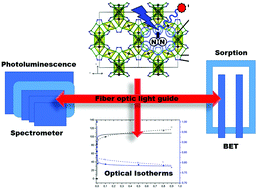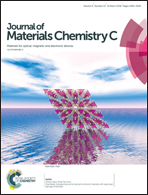Optical isotherms as a fundamental characterization method for gas sensing with luminescent MOFs by comparison of open and dense frameworks†
Abstract
Optical isotherms as a novel fundamental characterization method for MOF sensors are presented by a combination of simultaneous monitoring of sorption processes of different analyte gases (N2, Ar, CO2, and O2) together with in situ photoluminescence spectroscopy. Thereby, a direct correlation of both properties, luminescence and adsorption, is achieved, which provides a direct quantitative access to the effect of the MOF–analyte interaction on the photoluminescence of a MOF system. In addition, changes in equilibration time of the sorption process, temperature dependence and cyclic repetition can be systematically investigated. Thereby, optical isotherms establish a frame of reference for MOF luminescence sorption sensors. The MET MOF system (MET = metal triazolate) was chosen as a porous model candidate. A strong intensity increase of the photoluminescence of the MET-type MOF 3∞[Zn(Tz)2], (Tz− = 1,2,3-triazolate), was achieved by introduction of Mn2+ as a luminescence activator. Statistical replacement of Zn2+ with Mn2+ in 3∞[Zn0.9Mn0.1(Tz)2] retains the original structural microporosity. The obtained optical isotherms were further compared to results from a non-porous, luminescent coordination polymer 3∞[Sr0.95Eu0.05(Im)2] in order to elaborate the novel characterization concept in a broader context, showing that this concept is a fundamental step to achieve quantitative read-out of the sensing signal for both, porous and dense systems.



 Please wait while we load your content...
Please wait while we load your content...